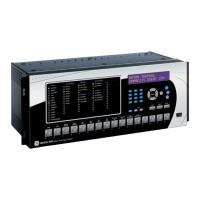5-172 M60 Motor Protection System GE Multilin
5.6 GROUPED ELEMENTS 5 SETTINGS
5
2. CT saturation
The characteristic allows for very sensitive settings when fault current is low and less sensitive settings when fault current is
high and CT performance may produce incorrect operate signals.
• STATOR DIFF LINE END SOURCE: This setting selects the source connected to CTs in the end of the machine stator
winding closest to the load and furthest from the winding neutral point. Both line and neutral-side CTs should be wired
to measure their currents in the same direction with respect to the neutral point of the winding.
If the two-speed motor functionality is employed with two separate CTs at each speed, the source which is sum of cur-
rents of two CT banks at line side should be assigned with this setting for proper differential functionality.
• STATOR DIFF NEUTRAL END SOURCE: This setting selects the source connected to CTs in the end of the machine
stator winding furthest from the load and closest to the winding neutral point. Both line and neutral-side CTs should be
wired to measure their currents in the same direction with respect to the neutral point of the winding.
• STATOR DIFF PICKUP: This setting defines the minimum differential current required for operation. This setting is
based on the amount of differential current that might be seen under normal operating conditions. A setting of 0.1 to
0.3 pu is generally recommended.
• STATOR DIFF SLOPE 1: This setting is applicable for restraint currents from zero to
STATOR DIFF BREAK 1, and defines
the ratio of differential to restraint current above which the element will operate. This slope is set to ensure sensitivity to
internal faults at normal operating current levels. The criteria for setting this slope is to allow for maximum expected CT
mismatch error when operating at the maximum permitted current. This maximum error is generally in the range of 5 to
10% of CT rating.
• STATOR DIFF BREAK 1: This setting defines the end of the Slope 1 region and the start of the transition region. It
should be set just above the maximum normal operating current level of the machine.
• STATOR DIFF SLOPE 2: This setting is applicable for restraint currents above the
STATOR DIFF BREAK 2 setting when
the element is applied to generator stator windings. This slope is set to ensure stability under heavy external fault con-
ditions that could lead to high differential currents as a result of CT saturation. A setting of 80 to 100% is recom-
mended. The transition region (as shown on the characteristic plot) is a cubic spline, automatically calculated by the
relay to result in a smooth transition between
STATOR DIFF SLOPE 1 and STATOR DIFF SLOPE 2 with no discontinuities.
• STATOR DIFF BREAK 2: This setting defines the end of the transition region and the start of the Slope 2 region. It
should be set to the level at which any of the protection CTs are expected to begin to saturate.
Figure 5–78: STATOR DIFFERENTIAL SCHEME LOGIC
SETTING
SETTINGS
FLEXLOGIC OPERANDS
FLEXLOGIC OPERANDS
FLEXLOGIC OPERANDS
SETTING
SETTING
SETTING
STATOR DIFF
FUNCTION:
STATOR DIFF
SLOPE 2:
STATOR DIFF
BREAK 1:
STATOR DIFF
BREAK 2:
STATOR DIFF
SLOPE 1:
STATOR DIFF
PICKUP:
STATOR DIFF PKP A
STATOR DIFF PKP B
STATOR DIFF DPO A
STATOR DIFF DPO B
STATOR DIFF BLOCK:
Off = 0
Enabled = 1
STATOR DIFF
LINE END SOURCE:
STATOR DIFF
NEUTR
AL END SOURCE:
IA
IA
IB
IC
RUN
RUN
RUN
Iad
Ibd
Icd
Iar
Ibr
AND
Restraint Phasors
Differential Phasors
DC Offset
Removal
D.F.T.
and
Differential
and Restraint
Iar
Iad
Ibd
Icd

